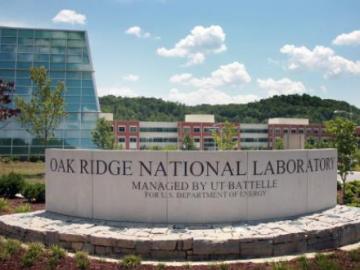ORNL's Communications team works with news media seeking information about the laboratory. Media may use the resources listed below or send questions to news@ornl.gov.
1111 - 1120 of 1132 Results

Methane hydrate isn't a familiar term to most people, but it's gaining popularity in the energy sector. Researchers believe there may be enough of this resource, which is methane locked in ice-like crystals, to supply energy for perhaps hundreds of years. Methane hydrates, which form at low temperat...

Nano-transistors 10 times smaller than conventional ones and being developed at ORNL could change the complexion of the electronics industry. Transistors, which can be used as amplifiers, detectors or switches, are integral parts of computers, telephones and virtually all electronic components. Trad...

Manure from the hundreds of millions of farm animals is a big problem, but it's one that, with some work, could become a strong renewable energy resource. As farm animal production has become more concentrated, handling the manure and run-off have become a serious problem. But animal manure, a valu...

An ORNL team will receive more than $1.1 million over the next three years to develop technology for reliable and automatic forewarning of failure in critical equipment at next-generation nuclear power plants. Such forewarning would allow timely maintenance to reduce unanticipated shutdown time and ...

With water heating consuming about 17 percent of the energy for a typical household, it's a good place to start when cutting costs. ORNL's Building Technology Center is assisting in developing a heat pump water heater as a "drop-in" replacement for a conventional 50- or 80-gallon water heater. It fe...

Researchers at the Holifield Radioactive Ion Beam Facility recently chalked up a physics "first": the simultaneous emission of two protons from an atom's decaying nucleus. The finding, based on preliminary experiments with the Holifield Facility's unique fluorine-17 beam, also represents a new type ...

ORNL researchers are developing a system that would provide an eight- to 50-minute warning before an epileptic seizure, giving a person time to take appropriate action. The system uses dime-size scalp electrodes that relay electroencephalographic signals to a computer for analysis. A warning alert w...

A whole new technology awaits exploration with the discovery of a technique for trapping single atoms, according to scientists at ORNL. Researchers at ORNL and Nanocrystals Technology in Briarcliff, N.Y., have collaborated to cage single europium atoms in nanocrystals not much larger than the atoms ...

In many of today's chemical applications, efficient mixing is critical to achieve product quality and uniformity, and ORNL engineers have devised a better way to do the mixing. The electrohydrodynamic micromixing reactor uses a specially designed electrified injection nozzle that mixes the chemicals...

Emergency responders have a new tool developed by ORNL that could save perhaps thousands of lives around the world. The LandScan Global Population Database is a worldwide source of population data with spatial precision to assess local impacts from floods, airborne contamination and other natural or...

